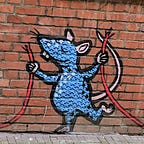End of an ERA
If you’re not a baseball fan, sorry! You can skip this post. Come back next week, when I promise to write something more interesting.
Okay, baseball nerds, it’s just us now. Happy new season!!!
This is what I was thinking while running yesterday morning: Major League Baseball (MLB) requires that a pitcher throw at least 162 innings to qualify for the Earned Run Average (ERA) title. But as Bill James noted years ago, over the history of professional baseball, starting pitchers have thrown progressively fewer innings. In the 1800s, one or two players did all the moundwork. By the early 1900s, teams went to starting rotations of three. After the Deadball Era and Babe Ruth’s popularization of home runs, rotations grew to four and the first hotshot relievers emerged (shout out to Firpo Marberry!). By the late 1960s, starting rotations expanded to five and the bullpen expanded to another five. Today it’s typical for a team to carry 12 pitchers — virtually half the roster — and for starters to go at most five or six innings, because the sabermetricians have discovered that most starters are effective the first couple of times through the batting order, but lose effectiveness the third time hitters see them.
If a healthy starting pitcher now works 32 games a year and throws five innings each time, his season total comes to 160 innings, two short of qualifying for the ERA title. So how many pitchers are even eligible to win the ERA title anymore? And how does that number compare to the old days?
I looked it up. (That’s easy to do when you have MLB.com, Retrosheet.org, and Baseball-Reference.com bookmarked.) In 2017, a grand total of 59 pitchers from the National and American Leagues threw enough innings to qualify for the ERA title.
In 1965, the year I became a baseball fan, 73 pitchers tossed enough frames to qualify for the ERA title. So that’s about a twenty percent drop in eligible pitchers over my lifetime.
Which is a more pronounced change than it sounds. In 1965, there were only twenty teams, so if each had a five-man rotation, it meant a hundred pitchers had a reasonable chance to throw 162 innings. In 2017, there were thirty teams, meaning there were 150 pitchers with a reasonable chance.
So whereas 73% of MLB starting pitchers qualified for the ERA title in 1965, only 39% qualified last year.
This is reflected in another statistic: the number of pitchers throwing 200 or more innings in a season. In 1965, 42 pitchers threw 200 or more innings. Last year, only 15 did.
So the question I pondered was whether it’s still reasonable to expect that a pitcher throw 162 innings to qualify for the ERA crown. And if it isn’t, what would be a more reasonable number?
The hardcore statheads will tell you those questions are irrelevant, because even though ERA is more meaningful than most of the old-fashioned statistics, it doesn’t account for environmental factors like ballpark dimensions, and it makes a dubious distinction between earned and unearned runs.
I get that. But to me there’s still something to be said — and rewarded — for giving your team a lot of quality innings, even if quality is imperfectly measured.
I think I’d be willing to come down to 150, but not many fewer than that. The average pitching staff threw 1,442 innings last year. Shouldn’t the ERA winner be expected to throw more than ten percent of his team’s total innings? One hundred and fifty barely exceeds that mark.
And consider this. In 1965, the ERA winners were Sandy Koufax in the National League and Sam McDowell — probably an even harder thrower than Koufax — in the American League. In 2017, the ERA winners were Clayton Kershaw in the National (the closest the Dodgers have come to cloning Koufax) and Corey Kluber in the American. These are not fluke winners; they have eight Cy Young awards among them, and the only one not to get a Cy Young (McDowell) led his league in strikeouts five times. Lowering the eligibility threshold makes it more likely a flash-in-the-pan pitcher gets the ERA title.
So, on second thought, to hell with progress. Keep the 162-inning minimum.
